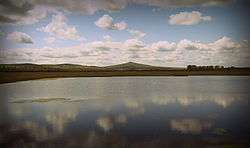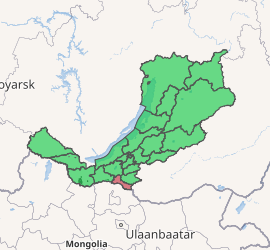Kyakhtinsky District
Kyakhtinsky District (Russian: Кя́хтинский райо́н, Russian pronunciation: [ˈkʲæxtʲɪnskʲɪj rəˈjon]; Buryat: Хяагтын аймаг, Khyaagtyn aimag) is an administrative[1] and municipal[6] district (raion), one of the twenty-one in the Republic of Buryatia, Russia. It is located in the south of the republic. The area of the district is 4,684 square kilometers (1,809 sq mi).[2] Its administrative center is the town of Kyakhta.[1] As of the 2010 Census, the total population of the district was 39,785, with the population of Kyakhta accounting for 50.3% of that number.[3]
Kyakhtinsky District Кяхтинский район | |
|---|---|
| Other transcription(s) | |
| • Buryat | Хяагтын аймаг |
 Lake Kiran in Kyakhtinsky District | |
.jpg) Flag .jpg) Coat of arms | |

Location of Kyakhtinsky District in the Buryat Republic | |
| Coordinates: 50°21′N 106°27′E | |
| Country | Russia |
| Federal subject | Republic of Buryatia[1] |
| Established | December 12, 1923[2] |
| Administrative center | Kyakhta[1] |
| Area | |
| • Total | 4,684 km2 (1,809 sq mi) |
| Population | |
| • Total | 39,785 |
| • Estimate (2018)[4] | 37,102 (-6.7%) |
| • Density | 8.5/km2 (22/sq mi) |
| • Urban | 58.9% |
| • Rural | 41.1% |
| Administrative structure | |
| • Administrative divisions | 1 Towns, 1 Urban-type settlements, 8 Selsoviets, 5 Somons |
| • Inhabited localities[1] | 1 Cities/towns, 1 Urban-type settlements[5], 40 Rural localities |
| Municipal structure | |
| • Municipally incorporated as | Kyakhtinsky Municipal District[6] |
| • Municipal divisions[6] | 2 Urban settlements, 15 Rural settlements |
| Time zone | UTC+8 (MSK+5 |
| OKTMO ID | 81633000 |
| Website | http://admkht.ru |
| 2010 Census | 39,785[3] |
|---|---|
| 2002 Census | 40,673[8] |
| 1989 Census | 45,224[9] |
| 1979 Census | 42,755[10] |
Geography
The district is located in southern Buryatia, near the Mongolia–Russia border, in the geographical region of the Selenga Highlands.
History
The district was established on December 12, 1923.[2]
Administrative and municipal status
Within the framework of administrative divisions, Kyakhtinsky District is one of the twenty-one in the Republic of Buryatia.[1] It is divided into one town (an administrative division with the administrative center in the town (an inhabited locality) of Kyakhta), one urban-type settlement (an administrative division with the administrative center in the urban-type settlement (inhabited locality) of Naushki), eight selsoviets, and five somons, all of which comprise forty rural localities.[1] As a municipal division, the district is incorporated as Kyakhtinsky Municipal District.[6] The town (together with one rural locality—the settlement of Sudzha) and the urban-type settlement are incorporated as two urban settlements, and the eight selsoviets and five somons are incorporated as fifteen rural settlements within the municipal district.[6] The town of Kyakhta serves as the administrative center of both the administrative[1] and municipal[6] district.
References
Notes
- Resolution #431
- Official website of the Buryat Republic. Information about Kyakhtinsky District (in Russian)
- Russian Federal State Statistics Service (2011). "Всероссийская перепись населения 2010 года. Том 1" [2010 All-Russian Population Census, vol. 1]. Всероссийская перепись населения 2010 года [2010 All-Russia Population Census] (in Russian). Federal State Statistics Service.
- "26. Численность постоянного населения Российской Федерации по муниципальным образованиям на 1 января 2018 года". Federal State Statistics Service. Retrieved January 23, 2019.
- The count of urban-type settlements may include the work settlements, the resort settlements, the suburban (dacha) settlements, as well as urban-type settlements proper.
- Law #985-III
- "Об исчислении времени". Официальный интернет-портал правовой информации (in Russian). June 3, 2011. Retrieved January 19, 2019.
- Russian Federal State Statistics Service (May 21, 2004). "Численность населения России, субъектов Российской Федерации в составе федеральных округов, районов, городских поселений, сельских населённых пунктов – районных центров и сельских населённых пунктов с населением 3 тысячи и более человек" [Population of Russia, Its Federal Districts, Federal Subjects, Districts, Urban Localities, Rural Localities—Administrative Centers, and Rural Localities with Population of Over 3,000] (XLS). Всероссийская перепись населения 2002 года [All-Russia Population Census of 2002] (in Russian).
- "Всесоюзная перепись населения 1989 г. Численность наличного населения союзных и автономных республик, автономных областей и округов, краёв, областей, районов, городских поселений и сёл-райцентров" [All Union Population Census of 1989: Present Population of Union and Autonomous Republics, Autonomous Oblasts and Okrugs, Krais, Oblasts, Districts, Urban Settlements, and Villages Serving as District Administrative Centers]. Всесоюзная перепись населения 1989 года [All-Union Population Census of 1989] (in Russian). Институт демографии Национального исследовательского университета: Высшая школа экономики [Institute of Demography at the National Research University: Higher School of Economics]. 1989 – via Demoscope Weekly.
- "Всесоюзная перепись населения 1979 г. Национальный состав населения по регионам России" [All Union Population Census of 1979. Ethnic composition of the population by regions of Russia] (XLS). Всесоюзная перепись населения 1979 года [All-Union Population Census of 1979] (in Russian). 1979 – via Demoscope Weekly (website of the Institute of Demographics of the State University—Higher School of Economics.
Sources
- Правительство Республики Бурятия. Постановление №431 от 18 ноября 2009 г. «О реестре административно-территориальных единиц и населённых пунктов Республики Бурятия», в ред. Постановления №573 от 13 ноября 2015 г. «О внесении изменений в Постановление Правительства Республики Бурятия от 18.11.2009 №431 "О реестре административно-территориальных единиц и населённых пунктов Республики Бурятия"». Вступил в силу 18 ноября 2009 г. Опубликован: "Бурятия", №216, Официальный вестник №120, 21 ноября 2009 г. (Government of the Republic of Buryatia. Resolution #431 of November 18, 2009 On the Registry of the Administrative-Territorial Units and the Inhabited Localities of the Republic of Buryatia, as amended by the Resolution #573 of November 13, 2015 On Amending Resolution #431 of November 18, 2009 of the Government of the Republic of Buryatia "On the Registry of the Administrative-Territorial Units and the Inhabited Localities of the Republic of Buryatia". Effective as of November 18, 2009.).
- Народный Хурал Республики Бурятия. Закон №985-III от 31 декабря 2004 г. «Об установлении границ, образовании и наделении статусом муниципальных образований в Республике Бурятия», в ред. Закона №1411-V от 14 октября 2015 г. «О внесении изменений в Закон Республики Бурятия "Об установлении границ, образовании и наделении статусом муниципальных образований в Республике Бурятия"». Вступил в силу со дня официального опубликования. Опубликован: "Бурятия", №1, Официальный вестник №1, 12 января 2005 г. (People's Khural of the Republic of Buryatia. Law #985-III of December 31, 2004 On Establishing the Borders, Creating, and Granting a Status to the Municipal Formations in the Republic of Buryatia, as amended by the Law #1411-V of October 14, 2015 On Amending the Law of the Republic of Buryatia "On Establishing the Borders, Creating, and Granting a Status to the Municipal Formations in the Republic of Buryatia". Effective as of the day of the official publication.).